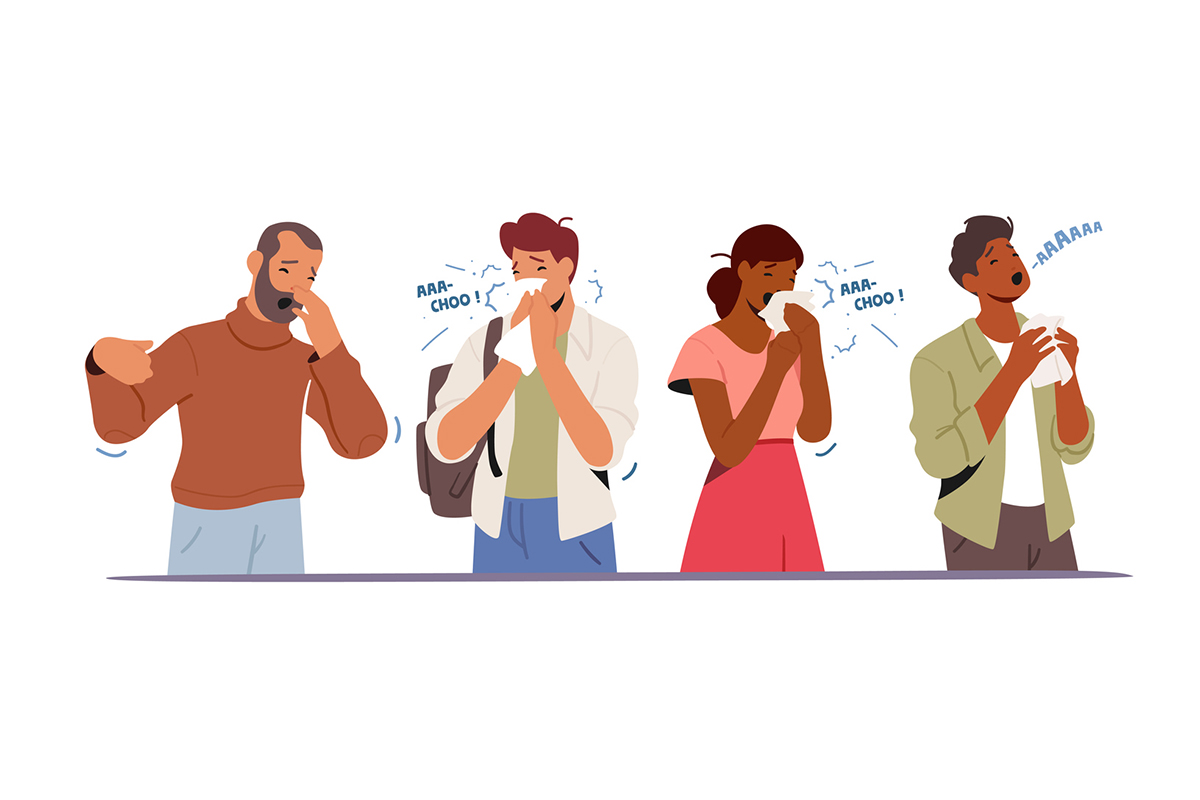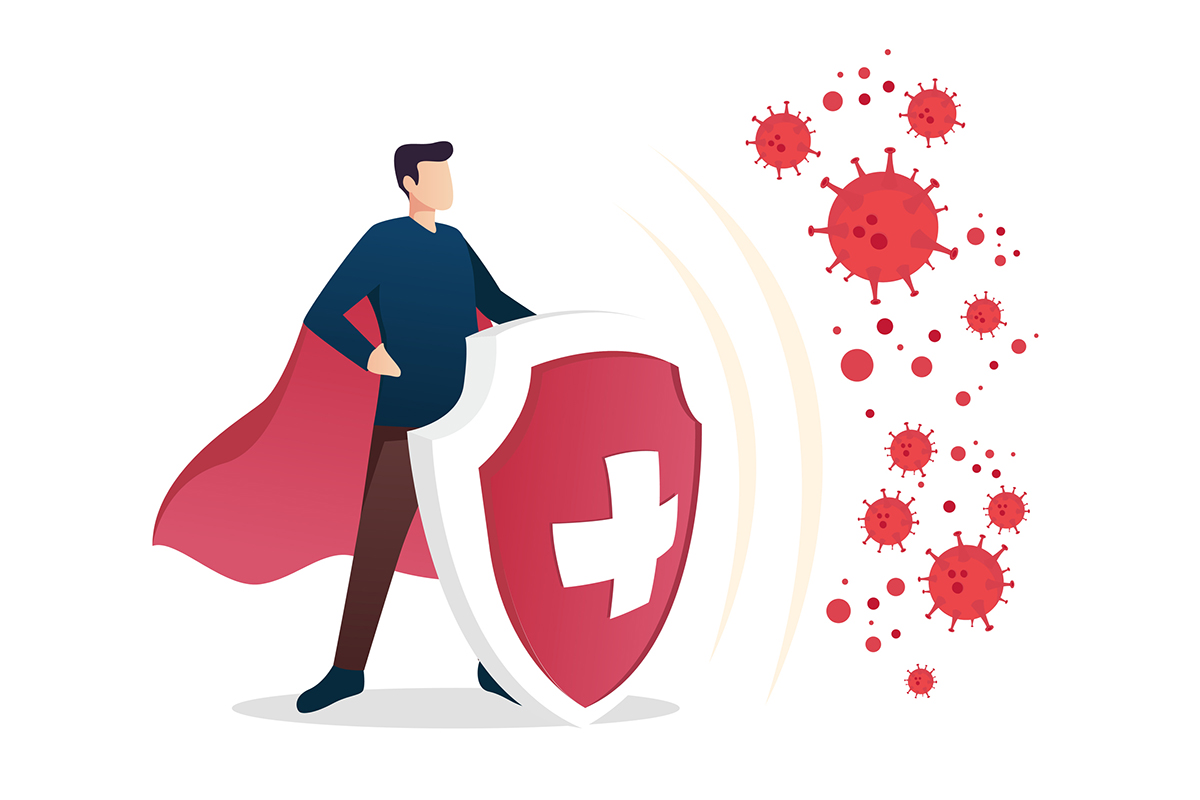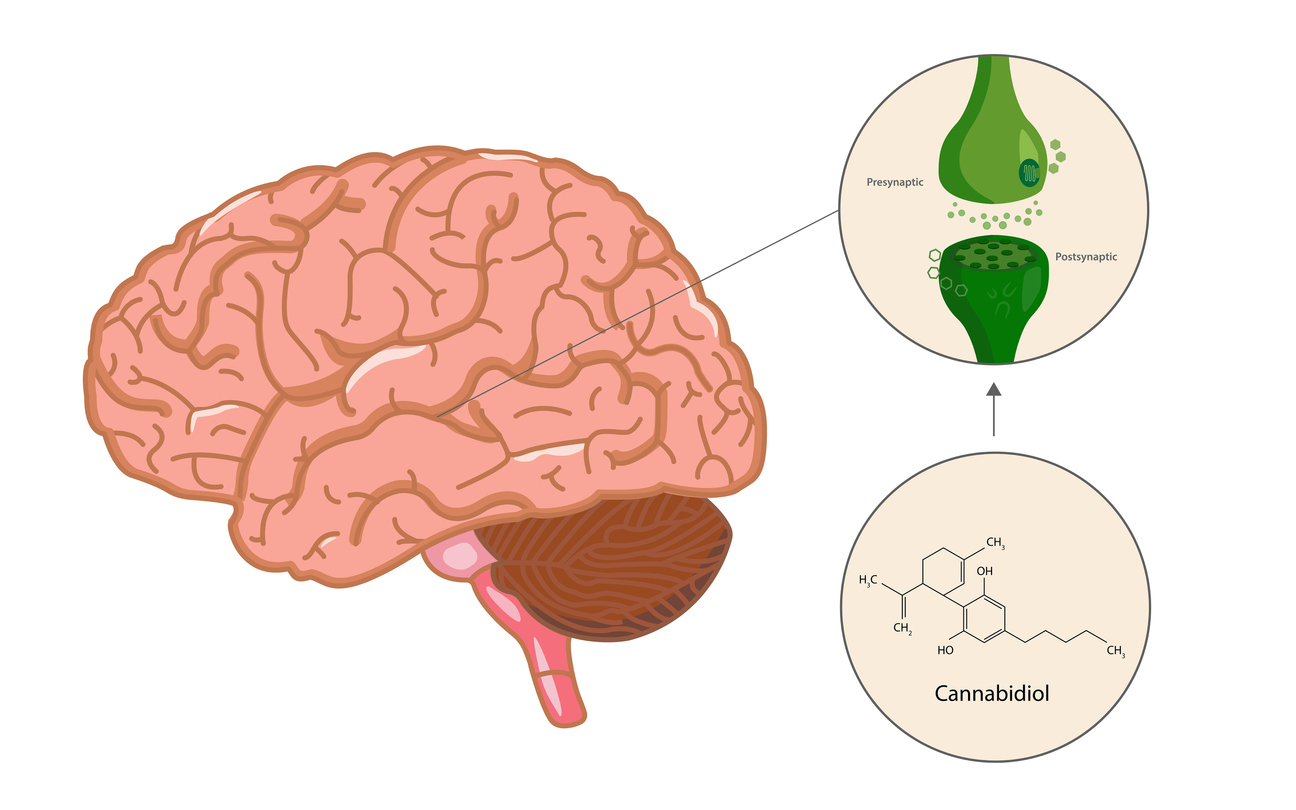Most of us think about how well our immune system is working only when we catch a cold, come down with the flu or catch a bug that’s going around. But, in fact, our immune system is constantly active, keeping all tissues and cells of the body under surveillance, patrolling the bloodstream, destroying precancerous cells, skirmishing with foreign bacteria and viruses, and absorbing smoke particles and environmental pollutants. Most of this action takes place without our being aware of it. Only when a virus gets a substantial foothold do we feel the side effects of an immune reaction: fatigue, achy muscles, headache, upset stomach, high fever. The symptoms make us want to stay home, curl up in bed and do nothing—an adaptive reaction that helps the body devote maximum energy to fighting the bug. Within a few days or a week, our immune system has shaken off the threat and we start to feel normal again, though we’re usually a little weak for a while.
Let’s look at a few of the special issues relating to infection and the immune response, and some of the common misconceptions about the process.
The end of the antibiotic age?
The first antibiotic, penicillin, was discovered in the 1920s as an accidental mold on a laboratory dish. More of these bacteria-killing molds were discovered and by the 1950s, researchers had begun to synthesize artificial ones. Pharmaceutical companies were turning them out by the ton, not only for treating disease in people but for preventing infections in cattle and poultry. These were truly miracle drugs, and the baby boomer generation was raised on them. Yet, right from the start, some researchers were warning against their overuse, and as early as the 1950s the phenomenon of drug resistance began to appear as bacteria mutated into new genetic forms that penicillin and other antibiotics couldn’t touch. The fact is that the increased use of antibiotics automatically increases the spread of resistant strains of microbes, and the past 40 years has seen a race between constantly mutating microbes and researchers trying to come up with new antibiotics to combat them. Antibiotic overuse has become a world problem, and an increasingly mobile population now carries its microbes and resistances across the globe. Bacteria are wondrously adept at passing on antibiotic resistances to their progeny. In fact, the process doesn’t depend entirely on natural selection, as we might expect. Bacteria can pass genetic material that confers resistance directly from one bacterium to another and even between different species. The process is so insidious that antibiotics given to farm animals can induce resistance not only in the animals who received them but in other livestock on the farm and in farm workers themselves. And bacteria that become resistant to one antibiotic are likely to confer resistance to several others as well.
It is not too alarmist to say that we actually may be looking at the end of the antibiotic age as we have known it. Already we are discovering new strains of old diseases for which we simply do not have any effective antibiotic treatment or have one that is prohibitively expensive or as dangerous as the disease itself. You’ve probably heard of the new strains of tuberculosis in American cities that are resistant to multiple antibiotics and can be treated only by combinations of three or four extremely expensive synthetic drugs. Well, this is only one example of a growing trend. On our continent and around the world, new strains of multiple-drug-resistant infections are cropping up—deadly diseases that have no real cure and can be “treated” only by quarantine.
Though a few voices are crying in the wilderness about this problem and the medical community is becoming more aware of it, too little is being done. Antibiotics are massively overprescribed and overused here in the United States and even more so in many countries where they are available without prescription. They often are consumed in quantities too low to eradicate an illness but just high enough to elicit resistance.
What can be done? First of all, we should scrupulously avoid any unnecessary antibiotic use. Too many Americans are in the habit of automatically calling up their doctors and demanding antibiotics when they get a cold or the flu, and too many doctors feel pressured to prescribe them, knowing that a patient can easily get them somewhere else. But antibiotics are completely useless against viruses—the kind that cause colds and flu. (Sometimes colds or flu can develop secondary bacterial infections, such as pneumonia, which do call for legitimate antibiotic treatment.) So if your doctor recommends going to bed and getting some rest as a treatment, don’t argue that you need antibiotics. Even if you think you “can’t” be sick for business reasons, the antibiotics will never, ever, cure the flu. But they will assuredly increase the risk of resistant bacteria in the future. They also are likely to kill off beneficial bacteria in the gut and increase the likelihood of opportunistic infections such as candida (yeast), which move in when the normal intestinal flora have been destroyed.
The misuse of properly prescribed antibiotics also can induce resistant strains of bacteria. Normally, it’s necessary to take antibiotics for seven to 10 days, even after symptoms of the illness have disappeared, to make sure that all of the disease-causing bacteria have been eradicated. If you stop taking an antibiotic too early, the drug has most likely wiped out only part of the bacterial population—the part that’s most susceptible to the antibiotic. The bacteria that remain are those that are most successful at resisting the antibiotic, and they can survive and multiply, passing on their resistant characteristics. Even if the infection doesn’t take hold again immediately, it will be less treatable with antibiotics in the future.
Besides avoiding unnecessary antibiotic treatment for ourselves, I think we have to be concerned as citizens about the massive dosing with antibiotics of livestock, agricultural crops and even fish in fish farms. Dosing crops or livestock can prevent infections and permit raising fish or animals in much more crowded quarters, thus increasing the “efficiency” of the operation and the final market yield. This lowers food prices, but even if traces of antibiotics don’t linger in the food itself, they can create resistant bacteria in the agricultural environment that can then be passed to humans.
There’s no question that we should take more precautions to prevent the spread of resistant strains of bacteria. But it may actually be too late on the worldwide scale. In years to come, we may be forced to return to measures such as quarantine and prevention that were in use nearly a century ago. More optimistically, we certainly should be turning our attention to ways of supporting our natural immune system and avoiding things that weaken it.
Fighting the flu
Sometime in the fall we start to hear the first predictions of the flu season and the name of the latest viral mutation. By December or January we have the grim flu watch on the news, telling us which state is hardest hit so far and how it’s spreading across the country. All this is accompanied by vivid advertisements for cold and flu remedies, which are now a multibillion dollar enterprise, though many of them are ineffective. Well, we all assume that it has something to do with the cold weather. But it’s curious to me that this epidemic coincides with the beginning of America’s nonstop feast and holiday season, which starts with Thanksgiving and continues on through New Year’s Day, by which time an enormous number of people have been stricken by the flu bug. It’s just possible that all of the excess holiday food and drink has taken its toll on the immune system. The sugar, the fat, the alcohol, along with the sleep deprivation from “shopping till you drop”—these are all known to suppress immune function. It’s not that the people have caught the bug, but that the bug has caught up with them.
We’ve already talked about how antibiotics are useless against the flu itself, though they are called for in the less common instances of secondary bacterial infections. But using antibiotics to try to treat the flu is not the only common erroneous practice. There is growing evidence that using aspirin or acetaminophen to reduce a fever during a flu attack may be counterproductive. Fever is one of the body’s natural defenses, and driving up body temperature can inhibit reproduction of some viruses and help burn away toxins. Reducing a fever with acetaminophen may actually extend the length of illness. I generally avoid taking fever-reducing drugs when I do get the flu. I let the fever build up to a nice, intense level, perhaps around 102F. I definitely feel wretched but find that the flu episode is usually pretty short-lived.
Actually, many elderly patients cannot mount a fever successfully. They may be very sick but with a temperature of perhaps only 99.5F, whereas younger, robust individuals may run a very high fever and show a very vigorous response to a virus, which they will then expel more quickly. Generally, people who can’t mount a fever have longer courses of illness, and people who do mount a fever get rid of an infection relatively quickly. Some caveats: Higher than 103F, a fever can become dangerous in an adult and should be reduced. In the elderly or in those with a weak heart, a high fever can put too much demand on the circulatory system and should be kept at a lower level. Children have a much greater tolerance for fever than adults do.
Should you get the flu shot?
Then there’s the question of the flu shot. Every autumn we start to hear announcements about when it will be ready and who should take it. Flu vaccines are a relatively new phenomenon, and there are certainly some people who should take them. Diabetics, people who have emphysema or chronic lung disease, and people who are susceptible to pneumonia or other secondary infections should definitely get a shot. Since flu viruses mutate wildly, a new vaccine has to be made up every year to protect against the new dominant strain. Some people do have some side effects from the shot, such as malaise or mild flu symptoms for a day or two. If you do get the vaccine, get it early in the season so it has time to boost your immunity before there’s any risk of exposure to the flu.
Some people want the vaccine just to avoid the inconvenience of getting the flu, but I think they are misguided. Having the flu or some other viral infection may actually serve as part of the natural regulation of the immune system. Having a healthy immune system doesn’t mean that you never get sick with a virus. When you get a viral infection your body mounts a healthy, normal immune response, and you get a fever, which adjusts the metabolism and literally burns up toxins. You could think of it as a kind of “boot camp” or training session for the immune system, which will increase your natural resistance.
Health care workers often are encouraged to take the flu vaccine on the theory that they are exposed to a lot of sick people and run a higher risk. I see plenty of sick people, but I’ve never gotten the shot, and I get the flu about once every three years. For a normally healthy person, I think this is a perfectly normal pattern and probably better for you in the long run.
It’s worth remembering that optimal immunity does not mean never getting sick. It means getting sick and responding in a supple fashion, without long, lingering consequences. I think of the immune response as being like an oriental martial art. In judo or tae kwon do or aikido, the object is not to form an impregnable wall against the invader but to respond in a flexible, fluid way to the attack and use the attacker’s own force to subdue him. That’s really a good way to think about immunity—in terms of suppleness of response, rather than a rigid barrier against diseases.
Simply going ahead and taking to bed when sick is one of our best natural responses. When animals get sick, they have the sense to go off by themselves and curl up in a ball and wait it out. But too often, we humans try to take drugs or symptom-suppressing medications to keep us on the go. We try to short-circuit the natural response to illness in ways that may actually extend the course of disease or weaken our resistance.
I think it’s interesting that sitting and reflecting are so discouraged in Western culture that we don’t want to do it even when we’re sick. In a way, illness can be a kind of forced meditation. It’s often the only time when we feel that it’s OK to stop and do nothing without feeling guilty. And this is certainly what our body wants us to do—it’s the message of viral fatigue.






